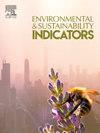Land use/cover classification using machine learning algorithms and their impacts on land surface temperature and soil moisture in the Alawuha Watershed, Ethiopia
IF 5.6
Q1 ENVIRONMENTAL SCIENCES
引用次数: 0
Abstract
Land use/cover (LULC) mapping is vital for natural resource management and environmental monitoring in rapidly developing regions such as Ethiopia's Northern Highlands. This study pioneers the integration of Sentinel-1 Synthetic Aperture Radar and Sentinel-2 Level 2A MultiSpectral Instrument data via Google Earth Engine to achieve high-accuracy LULC classification in the Alawuha Watershed, evaluating Classification and Regression Trees (CART), Random Forest (RF), and Support Vector Machines (SVM). It also examined spatiotemporal variations in land surface temperature (LST) and the soil moisture index (SMI) across LULC types using Landsat 8. The Radial Basis Function (RBF) SVM outperformed RF and CART, achieving an average overall accuracy (OA) of 89.6 % and an F1 score of 89.5 % across 2019 and 2024, compared to 88.2 % OA and 88.1 % F1 for RF, and 83.8 % OA and 83.3 % F1 for CART. Spatiotemporal analysis revealed urban expansion, increased forest cover, and stable farmland, with farmland consistently dominant in the watershed. LST decreased significantly from 2014 to 2025, with built-up areas showing the highest values at 41.4 °C (2019) and 38.1 °C (2024) and forests the lowest at 30.4 °C (2019) and 27.8 °C (2024). SMI increased significantly (2014–2025), with forests recording the highest values at 0.59 (2019) and 0.66 (2024), and built-up and bare lands the lowest. These findings highlight LULC's role in regulating microclimates and water balance, offering key insights for sustainable land-use planning and environmental management.
基于机器学习算法的土地利用/覆盖分类及其对埃塞俄比亚Alawuha流域地表温度和土壤湿度的影响
土地利用/覆盖(LULC)制图对于埃塞俄比亚北部高地等快速发展地区的自然资源管理和环境监测至关重要。本研究率先通过谷歌Earth Engine将Sentinel-1合成孔径雷达和Sentinel-2 Level 2A多光谱仪器数据集成,在Alawuha流域实现了高精度的LULC分类,并对分类与回归树(CART)、随机森林(RF)和支持向量机(SVM)进行了评估。本文还利用Landsat 8分析了不同土地利用类型的地表温度(LST)和土壤湿度指数(SMI)的时空变化。径向基函数(RBF)支持向量机优于RF和CART, 2019年和2024年的平均整体准确率(OA)为89.6%,F1得分为89.5%,而RF为88.2% OA和88.1% F1, CART为83.8% OA和83.3% F1。时空分析显示城市扩张、森林覆盖增加、农田稳定,农田在流域持续占主导地位。2014 - 2025年,地表温度显著下降,建成区在41.4°C(2019)和38.1°C(2024)时最高,森林在30.4°C(2019)和27.8°C(2024)时最低。2014-2025年,SMI显著增加,其中森林最高,分别为0.59(2019年)和0.66(2024年),建成地和裸地最低。这些发现突出了LULC在调节小气候和水平衡方面的作用,为可持续土地利用规划和环境管理提供了重要见解。
本文章由计算机程序翻译,如有差异,请以英文原文为准。
求助全文
约1分钟内获得全文
求助全文
来源期刊

Environmental and Sustainability Indicators
Environmental Science-Environmental Science (miscellaneous)
CiteScore
7.80
自引率
2.30%
发文量
49
审稿时长
57 days
 求助内容:
求助内容: 应助结果提醒方式:
应助结果提醒方式:


